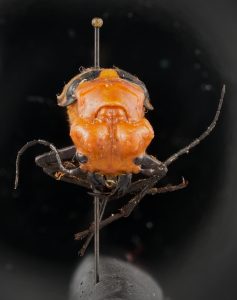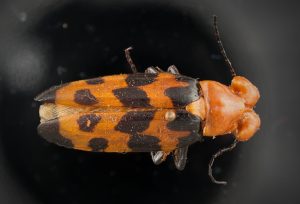By Theresa Dellinger
I’ve been sorting through some donated material over the past week and found a really cool insect to share today. When I first saw it, my reaction was “What is THAT?” There was no collection data label associated with this large specimen (approximately 30 mm in length), so I didn’t know when or where it was collected, which might have helped me identify the insect.
At first I thought this might be a very strange tiger beetle because of the large mandibles and long legs. But while cicindelids can be large, they don’t have this coloration and their heads don’t bulge like this.
Next I thought it might be an odd longhorn beetle, but again, not with that particular coloration or the weird head. Eventually the head and neck reminded me of the blister beetles and I was able to identify the specimen to species.
This is Cissites auriculata (Champion 1892), also known as the big-eared blister beetle (Coleoptera: Meloidae). These are impressively large beetles (19-37 mm) with striking orange and black coloration. Males have a curiously shaped head with bulging temples above the eyes (the “big ears”) and long, stout black mandibles. Females have a smaller head and shorter, stout mandibles. (There are some excellent photos of the heads of C. auriculata and its sister species Cissites maculata in García-París et al.’s 2013 paper). The larvae, like most meloid beetles, are parasitic on bees. The genus Cissites attacks carpenter bees (Xylocopa spp., Hymenoptera: Apidae) (references in Quinn 2011). Cissites auriculata is an uncommon species sometimes found at lights or searching for carpenter bee nests on wooden structures (García-París et al. 2013). The host range of C. auriculata is from Central America into Mexico and, more recently, into southern Texas (García-París et al. 2013; Quinn 2011).
I mentioned that this specimen has no collection label. Sadly, we cannot place it in the Virginia Tech Insect Collection without a label. Curators hate finding specimens without labels because these specimens cannot contribute any scientific information to what we know about the species. At the bare minimum, the collection date and locality of each specimen should always be recorded on a label placed on the pin. Labels now commonly include locality, date, collector names, time, elevation, geographic coordinates, habitat, weather, and even a data matrix code directing you to a database with additional maps or other information…a wealth of scientific data all in a legible format thanks to computers and printers.
Most entomologists, even amateurs, recognize the importance of a proper label for an insect specimen. However, when faced with processing a large number of insects, some students feel that labeling is just extra work after all the collecting, spreading, and pinning. Students may feel that they can trust their memory to where that specimen was collected and when, or that keeping this information in a field notebook is sufficient.
It’s not sufficient. It’s never sufficient. People forget details with time but insect collections may be preserved long beyond the lifespan of the collector. Field notebooks get separated from specimens or even lost entirely, and then the useful information vanishes, leaving the pinned specimen just an interesting biological artifact. If a collector is going to take the time to collect a specimen and properly pin it, why not take another couple of minutes to include the collection label?
For instance, we don’t know when or where this particular C. auriculata was collected. Did someone find it in Mexico or farther south into Central America? Or was this specimen collected in southern Texas, where the species appears to be expanding its range northward? Cissites auriculata was first collected in the United States at Big Bend National Park, Texas, in 2003 and 2004 (references in Quinn 2011; Lewis 2004). Since then, photos of C. auriculata from the lower Rio Grand Valley in Texas have been submitted to Bugguide.net with some regularity. A collection label could establish that this species was in southern Texas before the other reported U.S. records. Or not. The thing is, we have no label so we cannot make any inference about the specimen’s seasonality, range, or population. Our specimen could represent a unique population that no longer exists due to habitat loss, and tragically we would never be able to recognize that because there’s no label.
So what will become of our unlabeled but eye-catching C. auriculata? We’ll place it in an insect drawer to show people during tours of the collection. Large, colorful insects are always popular with visitors of all ages. Perhaps this beetle will inspire someone to learn more about entomology or biological diversity. Even better (in my opinion), this specimen can serve to illustrate a requisite lecture in Insect Biology detailing why collection information is so important for natural history specimens. This particular C. auriculata will hopefully remind future entomologists to always, always label their specimens.
References
García-París, M., C. Piñango, J. Mananilla, & A. Zaldívar-Riverón. 2013. On the presence of Cissites maculata (Coleoptera: Meloidae) in Mexico. Revista Mexicana de Biodiversidad 84(3): 855-864. doi:10.7550/rmb.33905
Lewis, A.E. 2004. A United States Record for the Genus Cissites Latreille (Coleoptera: Meloidae: Zonitini). The Coleopterists Bulletin 58(4): 635-636.
Quinn, M. 2011. Big-eared Blister Beetle. texasento.net/Cissites.htm



